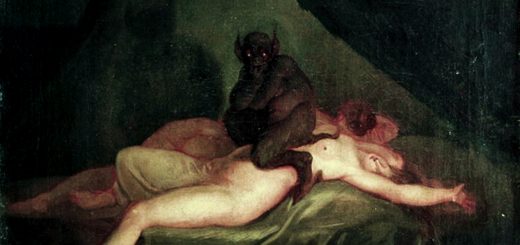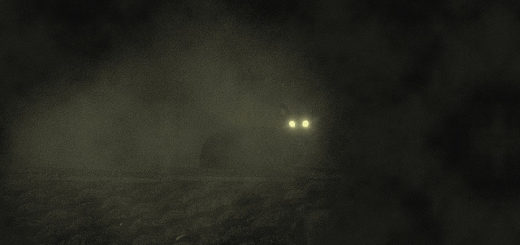Herbs of the Devil
The association between flowers and the Fairies, Pixies, or Elves was regarded vas very intimate. Therefore, it is not surprising to find that the King of Fairies, Puck, has a plant specially dedicated to him. This is the Lycoperdon, or Puckfist. Dr. Prior points out that in some old works Puck, who has the credit of being partial to coarse practical jokes, is alluded to as no other than the Devil.
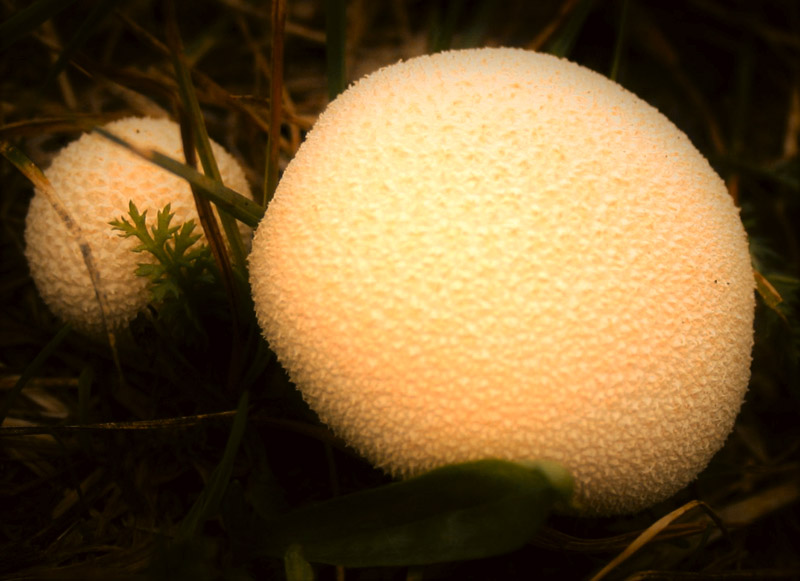
Lycoperdon, Puck’s Stool or Puckfist
His very name would seem to be derived from Pogge, a toad, which in popular opinion was the impersonation of the Devil: hence Toadstools, Pixie-stools, or Paddock-stools, were thought to be but Devil’s droppings—the work of those Elves
“Whose pastime
Is to make moonlight Mushrooms.”
In Sussex, the Puff-ball is called Puck’s Stool, and the needle of the Scandix Pecten is called Pook-needle. Loki, the Scandinavian malignant spirit, possesses many of the characteristics of Puck, and is in point of fact the Devil of the old Norse mythology. In Jutland, Polytrichum commune is called Loki’s Oats, and the Yellow Rattle is known there as Loki’s Purse. The Trolls, a race of gigantic demons, or evil spirits, spoken of in Northern mythology, have given their name to the Globe-flower (Trollius), which is also known as the Troll-flower, probably on account of its acrid and poisonous qualities having suggested its use by these followers of the Devil.

Puck by Sir Joshua Reynolds
Speaking generally, trees, plants, and herbs of evil omen may be placed in the category of plants of the Devil, and amongst them must be included such as have the reputation of being accursed, enchanted, unlucky, and sorrowful. The plants dedicated to Hecate, the Grecian goddess of Hell, who presided over magic and enchantments, as well as those made use of by her daughters Medea and Circe, in their sorceries, were all satanic. Circe was specially distinguished for her knowledge of venomous herbs, and in later times the plants used by her were universally employed by witches and sorcerers in their incantations. The spells of wizards, magicians, witches, and others who were acquainted with the secrets appertaining to the black art, were always made in the name of the Devil: hence all herbs and plants employed by them became veritable plants of the Devil.
Trees haunted by the Devil
The belief that certain trees are haunted by the Devil, or by malignant demons who act as his satellites, is of world-wide extent, and, in connection with tree spirits, the subject has been incidentally touched upon in the previous chapter. A Russian proverb says that “From all old trees proceeds either an owl or a Devil;” and in many countries where a tree becomes old and past bearing, its sterility is attributed to a demon. The Albanians believe that trees are haunted by Devils which they call aërico. Certain trees are especially affected by these aerial demons: these are the Fig, the Walnut, the wild Plum, the Mulberry, the Sycamore, the Pimpernel, the Willow, and in general all fruit trees (but especially the Cherry) when they are old and cease to bear. As regards sterile fruit trees, the belief that they are haunted by Devils is common to many countries. In some parts of England, Blackberries are never picked after Michaelmas-day, when the Devil is supposed to stamp them with his hoof. Mrs. Latham has told us that the watchfulness of the Devil makes it dangerous to go out nutting on a Sunday, and worthy mothers may be heard warning their children against it by assuring them that if they do so, “the Devil will hold down the branches for them.” Mr. Sawyer has pointed out that the Sussex saying, “as black as the Devil’s nutting bag,” is associated with this belief. St. Ouen, writing in the 17th century, cautioned shepherds and others never to let their flocks pass a hollow tree, because by some means or other the Devil was sure to have taken possession of it.
Moore, in ‘The Light of the Haram,’ speaks of the Siltim, a demon which is thought to haunt the forests of Persia, and to lurk among the trees in human form. The Indian demons bhûtûs and piçacâs are represented as dwelling in trees.
In the vicinity of Mount Etna the country people have a very strong aversion to sleep beneath trees on St. John’s Eve, lest they should become possessed of an evil spirit; for according to popular tradition, on that night—the shortest of the year—the demons inhabiting trees and plants quit their leafy habitations, and seek refuge in the first object they come across.
German field daemons
In Germany, numerous demons – here: daemons or small gods – are recognised as dwelling in trees; and, according to Prof. Mannhardt, whole troops of emissaries of the Devil (here better read: Pan, or the fertility gods and goddesses instead of Devil) are thought to haunt the fields, and lurk among the crops of Wheat and vegetables. Among the most noticeable of this legion are the Aprilochse, a daemon dwelling in the fields in April; Auesau, or Sow of the Wheatsheaf, a spirit which lies concealed among the Corn; Baumesel, a goblin of the trees; Erntebock, a demon which steals part of the Corn during harvest; Farre, or the Little Bull, one of a number of spirits dwelling in the Corn-fields; Gerstenwolf, or Barley-wolf, a demon which devours the Barley; Graswolf, a spirit haunting pastures; Habergeiss, or Haferbock, Goat of the Oats; Halmbock, a goblin whose hiding-place is among straw or the stems of plants; Heukatze and Heupudel, Hay Cat and Pup, demons dwelling in Hay; Kartoffelwolf, or Potato-goblin; Katzenmann, or Man-Cat, a monster dwelling amidst Wheat; Kleesau, or Sow of the Clover; Krautesel, or Ass of the Grass, a spirit especially inimical to Lettuces; Kornwolf, Kornsau, Kornstier, Kornkuh, Kornmutter, Kornkind, and Kornmaid, all daemons, spirits, who protected the harvest, fertility of the land and crops.

In German speaking countries and parts of the Slavonic and Mediterranean countries agricultural deamons protected the fields and harvest.
Invoking the Devil with a herb and cursed plants
In some parts of Russia the Devil is invoked through the medium of a herb. On the occasion of a marriage, the peasants put into a bottle of brandy a certain plant called the Herb of the Devil; the bottle is then ornamented with ribbons and coloured tapers, and armed with this present the father of the intended bride pays a visit to the father of the bridegroom, who offers to ransom this bottled Devil by the payment of five kopecks. “No,” says the girl’s father, “Our princess wishes more than that.” So after further bargaining, a price of fifty kopecks is finally agreed upon. In certain parts of Russia the Tobacco-plant is deemed a diabolic plant. In India the Witches’ Herb (Sinapis racemosa) is called Asurî (the she-devil).
A few plants named after dragons, serpents, or snakes, and many of those which are of a poisonous or noxious nature, must be classed with the plants of the Devil; such as, for example, the Upas, the Manchineel, the Magnolia, the Oleander, that deadly Persian flower, the Kerzereh, the fœtid Stapelia, the Phallus impudicus, the Thief’s Plant of the Franche-Comté Mountains, which opens all doors; that satanic plant, the sap of which gives to Witches the power of riding in the air on a broomstick; and the accursed plant which misleads the traveller, dragging him from one path to another, but always leading him farther and farther away from his goal, until at last he sinks exhausted with fatigue.
Certain plants and trees have become ill-omened from having received the maledictions of some divine personage. Several were cursed by the Virgin Mary during her flight into Egypt. The tree which yielded the timber of the Cross became for all time “the accursed tree”; the tree on which Judas hung himself became also a satanic tree. Under this ban have been included the Fig, the Tamarisk, the Aspen, the Dog Rose, the Elder, and the Cercis or Judas Tree.
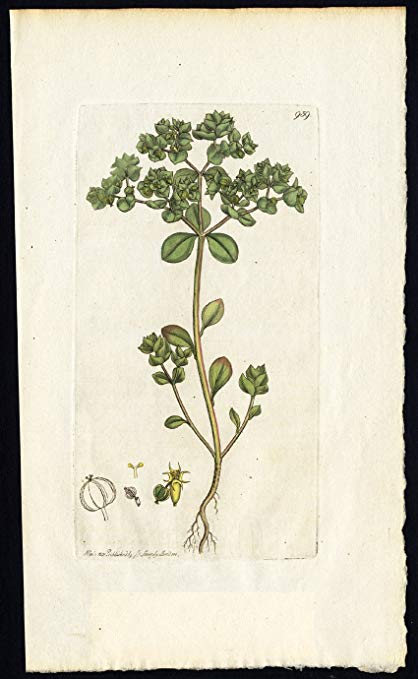
Petty Spurge (Euphorbia Peplus) Teufelsmilch, Devil’s Milk
Plants named after the Devil
Many plants, both in England and on the Continent, have been specially named after the Devil. Thus we find that, on account of the fœtid odour of the gum or juice obtain from its root, Ferula Assafœtida is known in Germany, Sweden, and Italy as Devil’s Dung (Stercus Diaboli), although it is employed in Persia and Arabia as a medicine, The Poplar-leaved Fig is the Devil’s tree; the berry of the Deadly Nightshade, the Devil’s berry: the plant itself is called Death’s Herb, and in olden times its fruit bore the name of Dwale-berry—the word dvale, which is Danish, meaning a deadly trance. An old German name for the Briony was Devil’s Cherry. The Germans, also, called the Petty Spurge (Euphorbia Peplus) Teufelsmilch, Devil’s Milk; a species of ground Moss, Teufelsklaeun, Devil’s Claws. The Clematis is the Devil’s Thread; Indigo, Devil’s Dye; and the Mandrake, from the lurid glare its leaves emit during the night-time, the Devil’s Candle. In an old work we find the description of a small herb called Clavis Diaboli, which is so poisonous that if cattle eat it they immediately begin to swell, and eventually die, unless by good luck they should happen to catch sight of another plant of the same species, when the poison is dispelled and the animals will recover. We are likewise assured that the seed is so poisonous as to render it unsafe for anyone to walk over a plant of this genus unless his feet have previously been wrapped in the leaves.
Scabiosa succisa is generally known as the Devil’s-Bit Scabious, a name it obtained from a notion which was formerly very prevalent that the short blackish root of the plant had originally been bitten short by the Devil out of spite to mankind, because he knew that otherwise it would be good for many profitable uses. This belief was also very general on the Continent, as the plant bears a corresponding name in France, Germany, and Holland. Dr. Prior quotes a legend recorded by Threlkeld, that “the root was once longer, until the Devil bit away the rest, for spite; for he needed it not to make him sweat who is always tormented with fear of the day of judgment.” According to the Ortus Sanitatis, on the authority of Oribasius, the plant was called Morsus Diaboli, “because with this root the Devil practised such power, that the mother of God, out of compassion, took from the Devil the means to do so with it any more; and in the great vexation that he had that the power was gone from him, he bit it off, so that it grows no more to this day.” Gerarde says: “The great part of the root seemeth to be bitten away: old fantasticke charmers report that the Devil did bite it for envie, because it is an herbe that hath so many good vertues, and is so beneficial to mankinde.” After recounting minor virtues, the old herbalist remarks that Devil’s Bit is potential against the stingings of venomous beasts, poisons, and pestilent diseases, and will consume and waste away plague sores, if pounded and laid upon them.
The Nigella Damascena is called Devil-in-the-Bush, from its round capsules peering from a bush of finely-divided involucre. The long awns of Scandix Pecten are termed the Devil’s Darning Needles, the beans of its seed vessels being called Venus’ comb. The Dodder (Cuscuta) has gained the opprobrious epithet of Devil’s Guts, from the resemblance of its stem to cat-gut, and its mischievous tendencies. The acrid milk or sap extracted from the Euphorbia has, from its poisonous qualities, obtained the name of Devil’s Milk. The poisonous Puff-balls (Lycoperdon) are called Devil’s Snuff-boxes, on account of the dust or particles they contain, which have long borne an ill name. Gerarde says that “it is very dangerous for the eies, for it hath been often seene that divers have beene pore-blinde ever after when some small quantitie thereof hath beene blowne into their eies.” The Fungus Exidia glandulosa (Witches’ Butter) is known in Sweden as the Devil’s Butter.
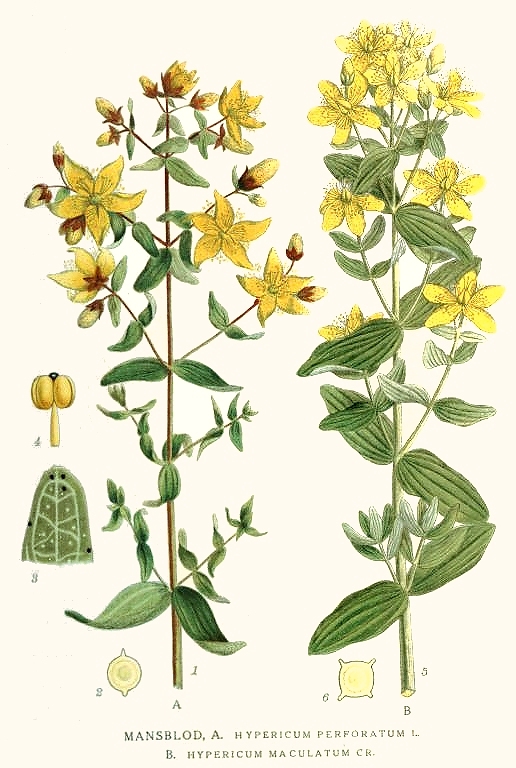
St. John’s worth
Although the Devil extends his authority over so many plants, it is satisfactory to know that the St. John’s Wort is a dispeller of demons (Fuga dæmonum), and that there is in Russia a plant called the Devil-chaser. Prof. De Gubernatis tells us that he has received from the Princess Galitzin Prazorova the following particulars of this plant, which is known as Certagon. It grows in meads and woods, is somewhat thorny, and bears a deep-blue flower. It protects infants from fright, and drives away the Devil. Sometimes the plant is boiled in water, and the children are bathed in it. At other times the plant is merely placed in the cradle. If mourners are prostrated with grief and the recollection of the departed one (which is simply a visitation of the Devil) it is only necessary to hold up a sprig of the mystic Certagon, when the excessive grief will be assuaged, and the Devil will be compelled to flee. The best way to exorcise an evil spirit from the dead is to sit on the pall, to chew some seeds of Camphor while combing the hair of the corpse, and finally to wave aloft the Certagon—the Devil-chaser.
Noxious, Deadly, and Ill-Omened Plants
Prof. De Gubernatis remarks that “there are good and bad herbs, and good and bad plants: the good are the work of Ormuzd, the bad the work of Ahriman.” All these bad herbs, plants, and trees, noxious, poisonous, and deadly—the dangerous classes in the vegetable kingdom—are of evil augury, and belong to the category of Plants of the Devil.
There are many trees and plants which emit emanations highly injurious, and in some cases fatal to life. Perhaps the most notorious of these is the deadly Upas, which rises in the ‘Valley of Death’ in Java, where it is said to blight all neighbouring vegetation, and to cause the very birds that approach it in their flight to drop down lifeless. No animal can live where its baneful influence extends, and no man durst approach its pestilential shade.
The Strychnos Tienté is the plant which yields the Upas Tienté, one of the Javanese poisons; it contains strychnia, and is as deadly as strychnine itself. The Upas Antiar is another Javanese poison—a bitter, milky juice, which acts violently on the heart.
The noxious exudations of the Manchineel-tree are said to cause certain death to those who rashly sleep beneath its foliage. The wonderfully fragrant blossoms of the Magnolia grandiflora emit so strong a perfume that, when inhaled in the immediate neighbourhood of a group in flower, it becomes overpowering. The Indians will never sleep under Magnolia in blossom.
Linnæus has mentioned a case in which the odour of the Oleander, or Rose-bay (Nerium Oleander), proved fatal. The foliage and flowers of this shrub will exercise a deadly influence on many quadrupeds: hence it is called in India the Horse-killer, and in Italy, Ass-bane.
The Elder-tree is reputed to exhale so narcotic a scent when in flower, that it is unwholesome for animals to rest under its shade; and it is considered unadvisable to plant one of these trees where its exhalations can be wafted into a sleeping apartment. On account of this pungent smell, country people often strike with Elder-boughs the leaves of fruit-trees and vegetables, in order that by being impregnated with the scent of the Elder-berries, they may prove noisome to troublesome insects.
The Jatropha urens, a native of Brazil, is a plant the properties of which are so noxious that its possession is absolutely fraught with danger. Not many years ago the Curator of Kew Gardens was one day reaching over a plant when its fine bristly stings touched his wrist: the first sensation was a numbness and swelling of the lips; the action of the poison was on the heart, circulation was stopped, and the unfortunate Curator soon fell unconscious. A doctor was fetched, who administered antidotes effectually; but no gardener could afterwards be got to come within arm’s length of the diabolical plant; and both it and another specimen, subsequently introduced, shortly afterwards mysteriously disappeared from the house.
The Nitraria tridentata, which is by some believed to be the Lotos-tree of the ancients, grows in the Desert of Soussa, near Tunis, and is called Damouch by the Arabs, who are fully alive to the semi-intoxicating qualities of its berries, which produce a state of lassitude similar to the infatuating food of the Lotophagi.
Alex Pouchkine has given a vivid description of the Indian Antchar, thought to be a variety Aconitum ferox. Growing in a wild and sterile desert, this Antchar has its roots and the sickly verdure of its branches steeped in poison. Melted by the mid-day heat, the poison filters through the plant’s outer skin in clammy drops: in the evening these become congealed into a transparent gum. Birds turn aside directly they see this deadly plant; the tiger avoids it; a passing puff of wind shakes its foliage,—the wind hurries on tainted and infected; a shower waters for an instant its drooping leaves, and from its branches forthwith falls a deadly rain on the burning soil. But a man has made a sign: another man obeys. The Antchar must be procured. He departs without hesitation; and on the morrow brings back the deadly gum, and some drooping stalks and leaves, while from his pallid brow the cold sweat falls in streams. He staggers, falls on the mats of the tent, and, poor miserable slave, expires at the feet of his proud master. And the prince steeps his ruthless arrows in the cruel poison; they are destined to carry destruction to his neighbours across the frontier.
In Mexico there grows a herb, familiarly known there as the Loco or Rattle Weed, which has such a powerful effect on animals, that horses eating it are driven raving mad.
In Scotland there is a certain weed that grows in and about the Borgie Well at Cambuslang, near Glasgow, which possesses the awful property of making all who drink of its waters mad. Hence the local saying:
“A drink of the Borgie, a bite of the weed,
Sets a’ the Cam’slang folk wrang in the head.”
Some few plants are repellent from the obnoxious smells which they emit: among these are the Phallus impudicus, and many of the Stapelias. One—the Carrion-flower—has an odour so like putrid meat, that flesh flies, attracted by it, deposit their ova in the flowers; and when the maggots are in due course produced, they perish miserably for lack of food.
Zahn, in his Speculæ Physico-Mathematico-Historicæ (1696) enumerates several trees and plants which had, in his day, acquired a very sinister reputation. He tells us that—
“Herrera speaks of a tree, in Granada, called Aquapura, which is so poisonous, that when the Spaniards, at first ignorant of its deadly power, slept under its shade, their members were all swelled, as if they had taken dropsy. The barbarians also, who lingered naked or intoxicated under it, had their skin broken by large swellings, which distended their intestines, and brought them to a miserable death.
“There is a tree in Hispaniola, bearing Apples of a very fragrant smell, which, if they are tasted, prove hurtful and deadly. If any one abides for a time beneath its shade he loses sight and reason, and cannot be cured save by a long sleep. Similar trees are found in the island Codega.
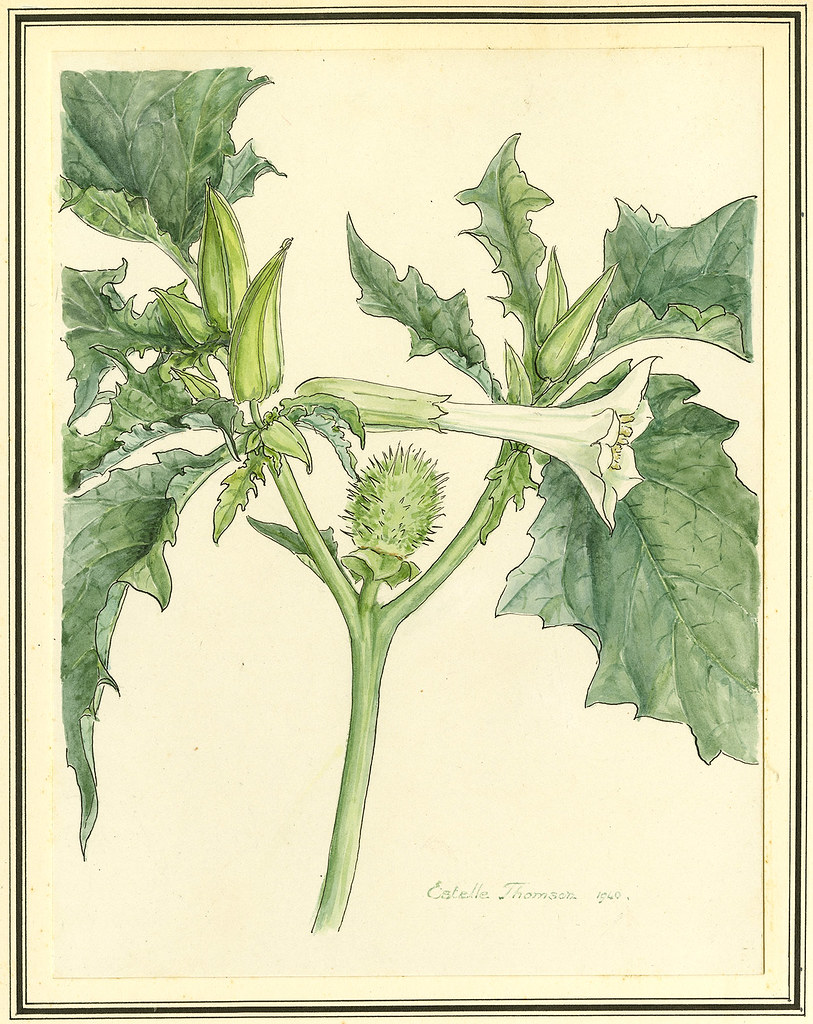
Datura stramonium
“In the same island, Hispaniola, another kind of tree is found which produces fruit formed like Pears, very pleasant to the sight, and of delicious odour. If any one lies beneath its shade and falls asleep, his face begins to swell, and he is seized with severe pain in the head, and with the sorest cold. In the same island another tree is found, whose leaf, if touched, causes at once a tumour of a very painful nature to break out, which can only be checked and healed by frequent washing with sea water. There also grows a plant called Cohobba, which is said to be lymphatic. It intoxicates by its mere smell, and renders fanatical, Cardanus believes this plant to be of the Stramonium (Datura) family, which infuriates those who drink it.
“In New Andalusia very poisonous trees are seen. If one of their leaves were to fall upon a person, he would be killed at once, unless the place be quickly smeared with the spittle of a fasting man. These trees are called pestiferous and pestilent, from the sudden death which they cause, like the plague.
“In the island of San Juan de Porto Ricco grow certain small fruit-bearing trees which are so pernicious that if a person lies down and sleeps beneath their shade, he is seized with paralysis and cannot move from the place. Should, perchance, a fish taste of their fallen leaves, and a man eat the fish, he either dies at once or at least loses all his hair.
“On an island near Brazil a very pleasant tree is said to grow, whose leaves are not unlike those of the Laurel. But if any person should touch ‘a leaf of this tree, and then touch his face and eyes with the hand, he is at once deprived of sight and suffers the severest pains in his eyes. Not far distant, however, there grows another tree, whose leaves, if rubbed over the eyes, restore the eyesight, and remove the pains.
“Kircher relates that a wonderful tree is found in the Philippine Islands. Its leaves, facing eastward, are healthy, but those facing westward are poisonous.
“Clusius states that in America there is a kind of Larch, which makes men who sleep under its shade so delirious, that when they are awakened, they are out of their minds and assume strange attitudes. Some act like prophets, some like soldiers, some like merchants, everyone for the time being as his natural propensity impels him.
“In the bishopric of New Spain, called Antequera, around the valley of Guaxaca, a strange poisonous plant is found which, if given to anyone in food or drink, at once causes death. If it is dried and removed anywhere, according to the time from its being cut, it kills. Thus: if it has been cut for a year, so after a year it causes death; if for a month, then after a month it brings death.
“The inhabitants of Macassar in the island of Celebes obtain from a certain tree growing there a most deadly and virulent poison, in which they dip their weapons. So pestiferous is this poisonous tree, that the earth around it for some distance produces neither grass nor vegetable life of any kind. Although instant death may sometimes be avoided by means of antidotes, yet the victim is doomed to die even after a lapse of two or three years. Married men and Mushroom-eaters are more subject to the action of this poison than other people.
“Ophiusa, in the island of Elephantine, in Ethiopia, has a livid and horrid appearance. If persons drink it they become dreadfully afraid of serpents—so much so, that they commit suicide. Palm wine, however, is said to counteract its influence.
“The plant called Apium risus is noxious, through causing those who partake of it to die of excessive laughter. Apuleius says that this is more particularly the case when the herb is taken by a person who has not broken his fast. From the fact that the plant was also known as Sardonia arose the expression “sardonic smile.” People who taste it do not die at once from laughter, but, as Salustius relates, rather from the contraction of the nerves of the lips and the muscles of the mouth; but they appear to die by laughing.
“In Bactria and around the Dnieper, a plant called Gelotophyllis is said to grow, which, if it be drunk with wine and myrrh, produces continuous laughter. A similar result is produced by Arum Ægyptiacum, when eaten, and by the flowers or seed of the Datura.
“Therionarca grows in Cappadocia and Mysia. All wild animals which touch it become torpid, and can only regain animation by being besprinkled with the water voided by hyænas.”
text adapted for blog, with some erroneous parts corrected was taken from “Plant Lore, Legends, and Lyrics” by Richard Folkard
You may also like to read:
The Witches’ointment
The Mystical Mandrake
Little Secrets of the Poppy
Datura stramonium or jimson weed or zombi-cucumber


